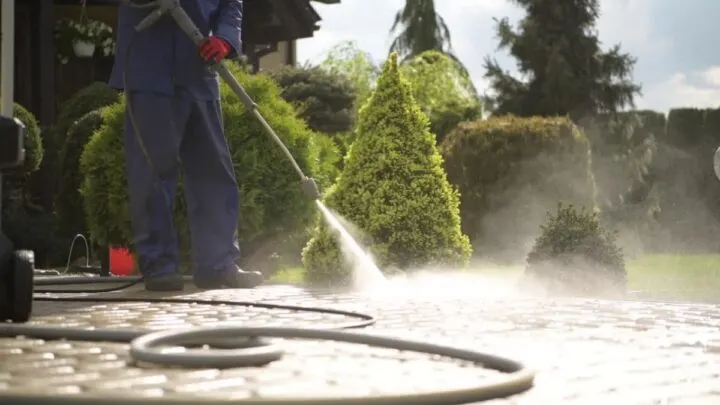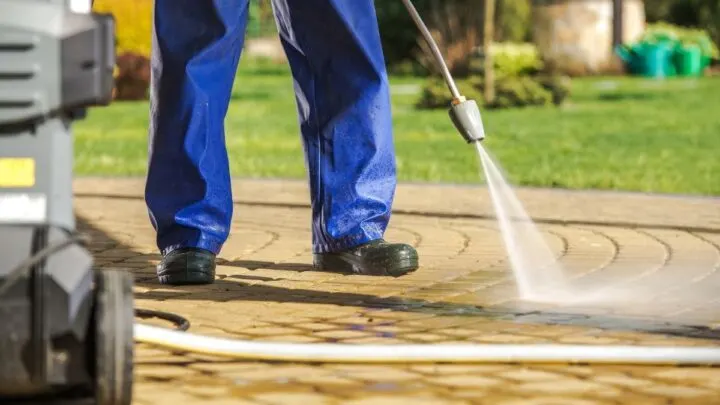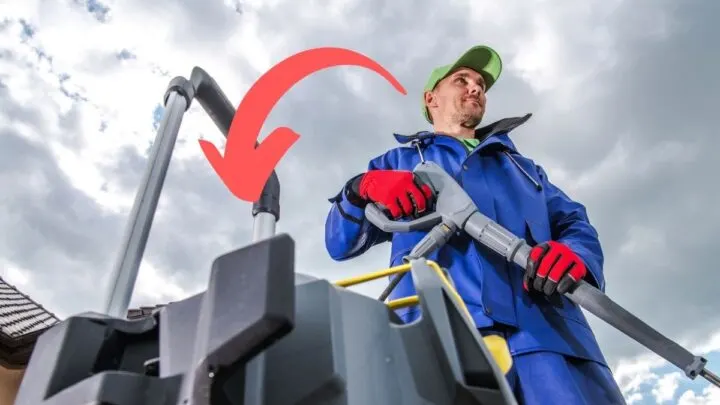If you’re the proud owner of a trusty pressure washer, I’m sure you enjoy splashing your outdoors and making them shine like a mirror.
Given their outstanding performance, you may want to be able to reach even further with these great tools.
Maybe you originally bought the washer for cleaning the car and the driveway. Now, you’re looking forward to sparkling the walkway and siding.
But there’s a bummer: the power washer can’t reach everywhere you would like! So how do you go about extending the pressure washer hose?
Your Options
One way to accomplish this task is to buy a longer hose. But if you need a more convenient and cost-effective option, then continue to read and you’ll find out precisely what you need to do.
If you buy another hose, it will be joined to your first hose by adapters and couplings to extend it. Ideally, you’d have two hoses of the same size in order to form a longer one.
If you happen to have two hoses of different diameters, connect the first one with the washer. Otherwise, the flow will get restricted, and there’ll be a pressure loss.
First Things First…
Before you begin, you should determine the washer’s minimum length that you need to get your jobs done. Then add a little more to your target length to stay on the safe side.
Once you’ve established the required length, go through the manual for the specifications.
Know Your Pressure Washer and Hose
Being of different diameters, each pressure washer is compatible with a specific type and size of hose. ¼-inch hoses are the most common among the newer washers, whereas ⅜ ones are older but are still in circulation.
As for hose lengths, these are generally 20 to 50-feet. If you’ve got a 20-foot one, you can still purchase a hose that’s 50 feet long, and it’ll be more than enough for most jobs.
Another issue to consider when it comes to the total length is the washer’s pressure. More length will inevitably cause more pressure loss.
So, for a long effective length, you’ll need enough PSI to pass the water through the whole length.
Finally, it’s crucial to know the pressurizing method your washer utilizes. The fittings and connections aren’t the same for a gas-powered or an electric pressure washer.
Usually, the gas-powered pressure washers have a much higher PSI than their electric counterparts. Thus, they need more heavy-duty connectors, fittings, etc.
Safety First!
It may not be apparent that pressure washers can be extremely dangerous, but water flowing at extremely high velocity can cause severe damage to the limbs, even lethal ones!
Lacerations caused by highly pressurized water aren’t as uncommon as you may think either.
Another potential source of injury is the explosion of the fittings. Such malfunction may cause the fittings to burst into several pieces, causing splinters to fly.
To avoid such accidents, you must ensure that there’s no compromise in the quality of the connectors, fittings, hoses, etc. On top of that, the pressure must always be kept within the limit recommended by the manufacturer.
There mustn’t be any sharp bend on an active hose either. And it would be best if you always switched off the washer and not left it running when it’s not in use.

Connections and Attachments, All You Need to Know
Connections are located at the ends of the hose. There are two types of connection, male and female, which are located at the opposite ends of the hose.
Apart from checking the quality of the connections, you’ll have to make sure that they’re the required diameters.
To add the male ends of two washers, couplings are used. These are fitted with female connections at both ends.
They have connections of different diameters at opposite ends. In the case of hoses with different diameters, the adapters are used.
Connections are readily available in any hardware store, you may choose from these three most commonly used types of connections:
Swivel Connections
These are used where a high degree of maneuverability is needed. Besides manageability, they are particularly suitable for preventing kinks. Its name is due to the swiveling function, which is also what helps prevent kinks.
M22 Connections
Primarily used in the electric pressure washers, these connections are equipped with metric threads. The solid, screw-tight connections are highly reliable.
Also, the O-rings on the male parts prevent leakage.
Quick Connections
As the name suggests, these connections are very easy and fast to connect. Their snap-on feature allows the connector to lock very easily.
Most quick-connect connections also feature a swiveling mechanism.
As for the fittings, they’re generally classified based on the building material. Brass, plastic, and stainless steel are the most commonly used.
Brass Fittings
Few metals or alloys can compete with brass in durability. Because of its extremely corrosion resistive nature, it’s used in most high-quality fittings. The downside is its relatively higher cost.
Plastic Fittings
Though not as durable as brass or stainless steel fittings, plastic fittings are extremely cost-effective and convenient. Electric pressure washers are commonly equipped with plastic fittings because of their relative low pressure.
Stainless Steel Fittings
Fittings made of stainless steel are also relatively common. Because of their corrosion and rust-proof nature, they’re extremely convenient for all things involving the casual use of water.
Stainless steel is much tougher than plastic or brass fittings.
Once you’ve checked the specifications of the pressure washer and the hose, you’ll be able to easily choose the connections, fittings, or attachments that are compatible with them in terms of size.
After selecting the specific type, you need will to figure out how frequently and roughly you want to use the washer.
Extension with a Single Hose
If you’ve got a hose that’s only a few meters smaller than the length you need, you may not need to extend the current hose by adding a new one. A single longer hose can do the job.
For example, if the hose you’ve got is 25-foot and you need to be in an area 35 feet away, you can buy a 50-foot hose and replace it with the original one.
It’ll be especially suitable for you if you don’t always need the longer length. You can switch from one hose to another as needed by the task.
This will also save you from the inconvenience of dangling around an unnecessarily big old hose. The details of the connecting process are in Step 1 of the next section.

Extending a Pressure Washer Hose with Two or More Hoses
If your target length is too long to be covered by a single hose, then you’ll have to add two or more hoses to get the desired length. It’ll take a bit of effort. But, if correctly done, it’ll more than make up for it.
Step 1: Connecting the Hose to the Pressure Washer
Pressure washers usually have a female connection, so you’ll have to connect the male end of the hose to the washer. If it’s a screw-tight type connection, screw it in.
Make sure not to make the joint too loose to cause leakage. And don’t tighten it too hard, to the point of wearing the grooves.
In the case of quick-connect connectors, the issue is much simpler. Just pull back the female end a little then insert the male end smoothly. Let go of the female end once the male end is in its position.
The two ends will interlock automatically.
Step 2: Connecting the Hoses
Regular male-to-female connectors are connected the same way you did with the pressure washer and hose connection. The same goes for the quick-connect connectors.
As for the couplings, you’ll have to screw in the hose’s male end to the washer’s male end. Then the other male end of the adapter should be screw-connected to the female end of the coupler.
Similarly, follow through with the other connections of the hose.
Step 3: Connecting the Hose to the Spray Gun
Spray guns are usually equipped with quick-connect connectors. So, the connecting method is the same as explained above. In multiple fittings, especially in the older guns, you’ll have to use adapters.
Final Thoughts on Extending a Pressure Washer Hose
Once you’ve extended the pressure washer hose, check the assembly by carrying out a test wash. To be on the safe side, begin with low pressure by lowering the washer’s PSI.
Look for leaks and kinks as well. In case of leaks, adjust the fittings and connections. If it still doesn’t stop, then the issue is with the O-ring.
You’ve done a marvelous job if there isn’t any leakage even at the higher PSIs. Go ahead and clean anything you want!


